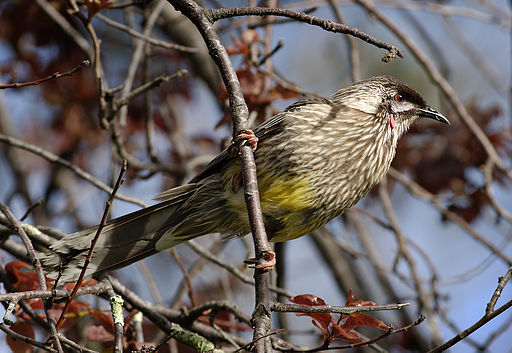The Red Wattlebird, a honeyeater, is one of those birds I see, or hear, almost every day. Native to Australia, and named after the fleshy wattle hanging from both sides of the neck.

A Red Wattlebird in a Cherry tree in Victoria, Australia, showing distinctive underside markings and colouring. [ By Mick Stephenson mixpix 00:54, 1 November 2007 (UTC) (Own work) [GFDL or CC-BY-SA-3.0], via Wikimedia Commons ]
The red wattlebird (Anthochaera carunculata), also known as barkingbird or gillbird, is a honeyeater; a group of birds found mainly in Australia and New Guinea which have highly developed brush-tipped tongues adapted for nectar feeding. The tongue is flicked rapidly and repeatedly into a flower, the upper mandible then compressing any liquid out when the bill is closed.
Although honeyeaters look and behave very much like other nectar-feeding passerines around the world (such as the sunbirds and flowerpeckers), they are unrelated, and the similarities are the consequence of convergent evolution. The red wattlebird is a large (up to 35 cm) grey-brown honeyeater with red eyes, distinctive red wattles either side of the neck and white streaks on the chest and belly, which reveals a bright yellow patch towards the tail. Juveniles are generally less flamboyant, with less prominent wattles and browner eyes.
The species is found in SE Queensland, New South Wales, Victoria, South Australia and southwest Western Australia in open forest, woodland, and near human habitation. The nest is formed from sticks and leaves lined with bark and hair, between 2 and 16 metres above ground, usually in the forked branches of a tree or shrub, in which two or three, pale brown-spotted pink eggs are normally laid.
In addition to nectar, it takes insects and other small creatures, usually by hawking, and also berries and other fruit.
This bird was first described by John White in his Journal of a Voyage to New South Wales (1790).
I found the above-mentioned John White’s Journal of a Voyage to New South Wales (1790) on Gutenberg Australia. John White named this new species as the Wattled Bee-eater.
The Wattled Bee-eater, of which a plate is annexed, fell in our way during the course of the day. This bird is the size of a missel thrush but much larger in proportion, its total length being about fourteen inches. The feathers on the upper part of the head, longer than the rest, give the appearance of a crest; those of the underpart are smooth; the plumage for the most part is brown, the feathers long and pointed, and each feather has a streak of white down the middle; under the eye, on each side, is a kind of wattle, of an orange colour; the middle of the belly is yellow; the tail is wedge-shaped, similar to that of the magpie, and the feathers tipped with white; the bill and legs are brown. This bird seems to be peculiar to New Holland, and is undoubtedly a species which has not hitherto been described.
I wonder if he is describing the Yellow Honeyeater – it has distinct yellow wattles and is our largest honeyeater. Australia was New Holland in those days, and New South Wales originally covered all the eastern side of the continent, with Tasmania known as Van Dieman’s Land – though it isn’t shown as an island in this map from 1790.
![New Holland & the adjacent islands, agreeable to the latest discoveries [cartographic material]. 1790. MAP T 800.](https://christine-j-randall.com/wp-content/uploads/2015/07/nla-map-t800-v.jpg?w=696&h=567)
New Holland & the adjacent islands, agreeable to the latest discoveries [cartographic material].
1790. MAP T 800. National Library of Australia


Haven’t seen him, but recognise the ‘voice’, hard to miss.
LikeLiked by 1 person
I was astounded to see how tame this one was … I can’t get close enough to ours for a photo.
LikeLike
I think the ones we have here in Tassie are the yellow ones, and after listening to your video I can tell you that ours have a much more intense and raucous call. In my former home I had a large garden and one pair nested in the silver birches one year, birches were very handy to the plum tree, which these birds used to great advantage as the plums ripened.They are not a particularly favourite bird of mine.
LikeLiked by 1 person
I agree about the call, I think the one in the video is diluted a bit by the background bird calls. Yeah, I imagine they’d love plums!
LikeLike
Great close up shots and the sounds are amazing. Our honey eaters, I think, are slightly different. I don’t remember the pink on ours, rather yellow instead. Must have another look! 🙂
LikeLiked by 1 person
Well, the wattlebird is a honey eater. That main photo won some internet award, it deserved it. Fabulous. I’m impressed with the YouTube video too, so clear and so close to the bird.
LikeLiked by 1 person
Sorry, I mean wattlebirds!
LikeLike